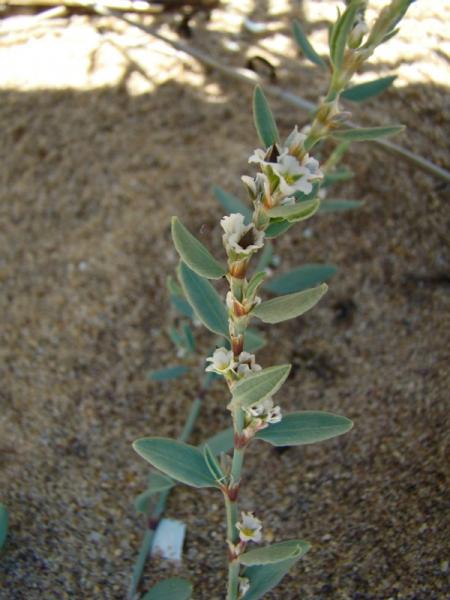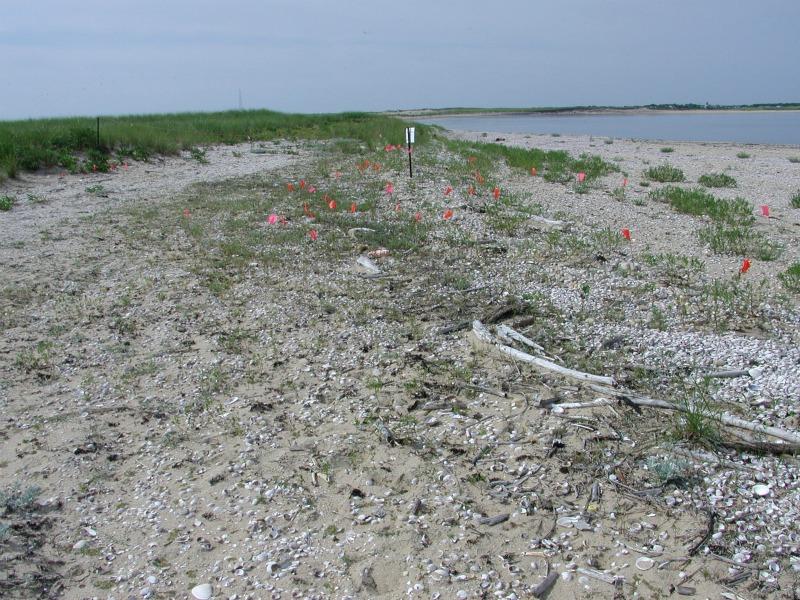Seabeach Knotweed
Polygonum glaucum Nutt.
- Class
- Dicotyledoneae (Dicots)
- Family
- Polygonaceae (Buckwheat Family)
- State Protection
- Rare
A plant listed as Rare by New York State. Removal or damage without the consent of the landowner is prohibited.
- Federal Protection
- Not Listed
- State Conservation Status Rank
- S3
Vulnerable in New York - Vulnerable to disappearing from New York due to rarity or other factors (but not currently imperiled); typically 21 to 80 populations or locations in New York, few individuals, restricted range, few remaining acres (or miles of stream), and/or recent and widespread declines.
- Global Conservation Status Rank
- G3
Vulnerable globally - At moderate risk of extinction due to rarity or other factors; typically 80 or fewer populations or locations in the world, few individuals, restricted range, few remaining acres (or miles of stream), and/or recent and widespread declines.
Summary
Did you know?
Even though this beach plant seems secure on Long Island, our state has the most populations in the world and the species is much more rare in other parts of its range.
State Ranking Justification
There are 43 existing populations but about half of them are small with less than 100 plants. There are no other older populations which have not been rediscovered. Numbers fluctuate from year to year in its dynamic beach habitat so quantity and quality of populations are based upon five-year averages.
Short-term Trends
Short-term trends seem stable although there can be wide fluctuations in plant numbers from year to year.
Long-term Trends
Populations have remained relatively stable since it was first documented in 1861 and New York harbors the largest number of populations in the world.
Conservation and Management
Threats
The plants are subject to the natural threats of storm damage and succession by beachgrasses. Humans threaten the plants by driving over them with vehicles, beach raking, and by trampling them.
Conservation Strategies and Management Practices
Seabeach knotweed needs wide natural beaches free from vehicle use and excessive trampling. The use of string fencing provides enough protection to enable it to germinate and produce fruit.
Research Needs
There are a number of research needs to understand its distribution, germination and growth, and interaction with its environment.
Habitat
Habitat
In New York Polygonum glaucum is known only from maritime beaches and the margins of adjacent dunes and salt marshes. It may be the dominant plant in areas of little or no other vegetation. It grows in open conditions on a variety of substrates, including, sand, silt, pebbles or cobbles, and dredging spoils (New York Natural Heritage Program 2011). Maritime beaches (FNA 2005). Sandy beaches (Gleason and Cronquist 1991).
Associated Ecological Communities
- High salt marsh*
(guide)
A coastal marsh community that occurs in sheltered areas of the seacoast, in a zone extending from mean high tide up to the limit of spring tides. It is periodically flooded by spring tides and flood tides. High salt marshes typically consist of a mosaic of patches that are mostly dominated by a single graminoid species.
- Maritime beach
(guide)
A community with extremely sparse vegetation that occurs on unstable sand, gravel, or cobble ocean shores above mean high tide, where the shore is modified by storm waves and wind erosion.
- Maritime dunes
(guide)
A community dominated by grasses and low shrubs that occurs on active and stabilized dunes along the Atlantic coast. The composition and structure of the vegetation is variable depending on stability of the dunes, amounts of sand deposition and erosion, and distance from the ocean.
* probable association but not confirmed.
Associated Species
- Achillea millefolium (yarrow)
- Amaranthus palmeri (Palmer's amaranth)
- Ammophila breviligulata (beach grass)
- Apocynum cannabinum (Indian-hemp)
- Artemisia campestris ssp. caudata (sand wormwood)
- Artemisia stelleriana (beach wormwood, dusty miller)
- Asparagus officinalis (asparagus)
- Atriplex arenaria
- Atriplex cristata
- Atriplex patula (spear orach)
- Baccharis halimifolia (groundsel-tree)
- Bolboschoenus robustus (sea-coast bulrush)
- Cakile edentula
- Chamaesyce polygonifolia
- Cichorium intybus (chicory)
- Cycloloma atriplicifolium (winged-pigweed)
- Elaeagnus umbellata (autumn-olive)
- Honckenya peploides ssp. robusta (sea-beach-sandwort)
- Iva frutescens (salt marsh-elder)
- Juniperus virginiana
- Lathyrus japonicus
- Lepidium campestre (field cress)
- Leucanthemum nipponicum
- Myrica gale (sweet gale)
- Papaver orientale
- Plantago maritima var. juncoides (seaside plantain)
- Polygonum aviculare ssp. buxiforme
- Portulaca oleracea (purslane)
- Rosa multiflora (multiflora rose)
- Salsola kali
- Solidago sempervirens (northern seaside goldenrod)
- Suaeda calceoliformis (horned sea-blite)
- Taraxacum officinale (common dandelion)
- Toxicodendron radicans
- Triplasis purpurea
- Xanthium strumarium var. canadense (Canada cocklebur)
Range
New York State Distribution
This low herb is native to the beaches of Long Island with one old unconfirmed report from Long Island Sound in Westchester County.
Global Distribution
It is rare throughout its range on the coastal beaches from Maine south to Northern Florida. It is most common in Massachusetts and New York and very rare elsewhere.
Identification Comments
General Description
Seabeach Knotweed is a silvery or whitish annual herb, with prostrate or somewhat ascending stems, branching from the base and up to 70 centimeters long. A characteristic of all Polygonum species is that their stipules are united to form a sheath around the stem (called an "ocrea") at each node. In this species the ocrea is 7 to 15 millimeters long, with the proximal part glaucous. The leaves are 10 to 30 mm long with the edges rolled under. The flowers are in clusters of 1 to 3, emerging from the leaf axils, each flower with 8 stamens and 5 tepals. The tepals are 3 to 4 mm long and white (sometimes with pink edges). The fruit are reddish -brown, smooth, 3-sided achenes 2.5 to 3 mm long (late season achenes may reach 5 mm) exserted (sticking out) from the perianth (FNA 2005).
Best Life Stage for Proper Identification
Seabeach knotweed is most easily identified in fruit, though it may be identifed in vegetative form as well.
Similar Species
Small's Knotweed is another Polygonum species rare in New York which occupies maritime beaches and dunes. among the Polygonum species present within New York. It differs from P. glaucum by having ocreas only half as long (up to 6.5 mm) and not glaucous, leaves not glaucous or revolute, cucullate flowers, and achenes not exserted from the perianth.
Best Time to See
Seabeach Knotweed flowers beginning in July and the fruits may persist past the first frost.
- Flowering
- Fruiting
The time of year you would expect to find Seabeach Knotweed flowering and fruiting in New York.
Seabeach Knotweed Images
Taxonomy
Seabeach Knotweed
Polygonum glaucum Nutt.
- Kingdom Plantae
- Phylum Anthophyta
- Class Dicotyledoneae
(Dicots)
- Order Polygonales
- Family Polygonaceae (Buckwheat Family)
- Order Polygonales
- Class Dicotyledoneae
(Dicots)
- Phylum Anthophyta
Synonyms
- Polygonum maritimum L. [Misapplied to New York sprcimens.]
- Polygonum raii Bab. [Misapplied to New York specimens.]
Additional Resources
Best Identification Reference
Flora of North America Editorial Committee. 2005. Flora of North America North of Mexico, Volume 5, Magnoliophyta: Caryophyllidae, Part 2. Oxford University Press, New York.
Other References
Crow, Garrett E. and C. Barre Hellquist. 2000. Aquatic and Wetland Plants of Northeastern North America: A revised and enlarged edition of Norman C. Fassett's a Manual of Aquatic Plants. Volume One: Pteridophytes, Gymnosperms, and Angiosperms: Dicotyledons. The University of Wisconsin Press. Madison, Wisconsin. 536 Pages.
Fernald, M.L. 1950. Gray's manual of botany. 8th edition. D. Van Nostrand, New York. 1632 pp.
Gleason, Henry A. and A. Cronquist. 1991. Manual of Vascular Plants of Northeastern United States and Adjacent Canada. The New York Botanical Garden, Bronx, New York. 910 pp.
Holmgren, Noel. 1998. The Illustrated Companion to Gleason and Cronquist's Manual. Illustrations of the Vascular Plants of Northeastern United States and Adjacent Canada. The New York Botanical Garden, Bronx, New York.
Mitchell, Richard S. and Gordon C. Tucker. 1997. Revised Checklist of New York State Plants. Contributions to a Flora of New York State. Checklist IV. Bulletin No. 490. New York State Museum. Albany, NY. 400 pp.
Mitchell, Richard S. and J. Kenneth Dean. 1978. Polygonaceae (buckwheat family) of New York State. Contributions to a flora of New York State. Richard S. Mitchell, ed. New York State Museum Bulletin No. 431. 79 pp.
New York Natural Heritage Program. 2010. Biotics database. New York Natural Heritage Program. New York State Department of Environmental Conservation. Albany, NY.
New York Natural Heritage Program. 2024. New York Natural Heritage Program Databases. Albany, NY.
Weldy, T. and D. Werier. 2010. New York flora atlas. [S.M. Landry, K.N. Campbell, and L.D. Mabe (original application development), Florida Center for Community Design and Research http://www.fccdr.usf.edu/. University of South Florida http://www.usf.edu/]. New York Flora Association http://newyork.plantatlas.usf.edu/, Albany, New York
Links
About This Guide
Information for this guide was last updated on: November 7, 2011
Please cite this page as:
New York Natural Heritage Program. 2024.
Online Conservation Guide for
Polygonum glaucum.
Available from: https://guides.nynhp.org/seabeach-knotweed/.
Accessed July 26, 2024.



